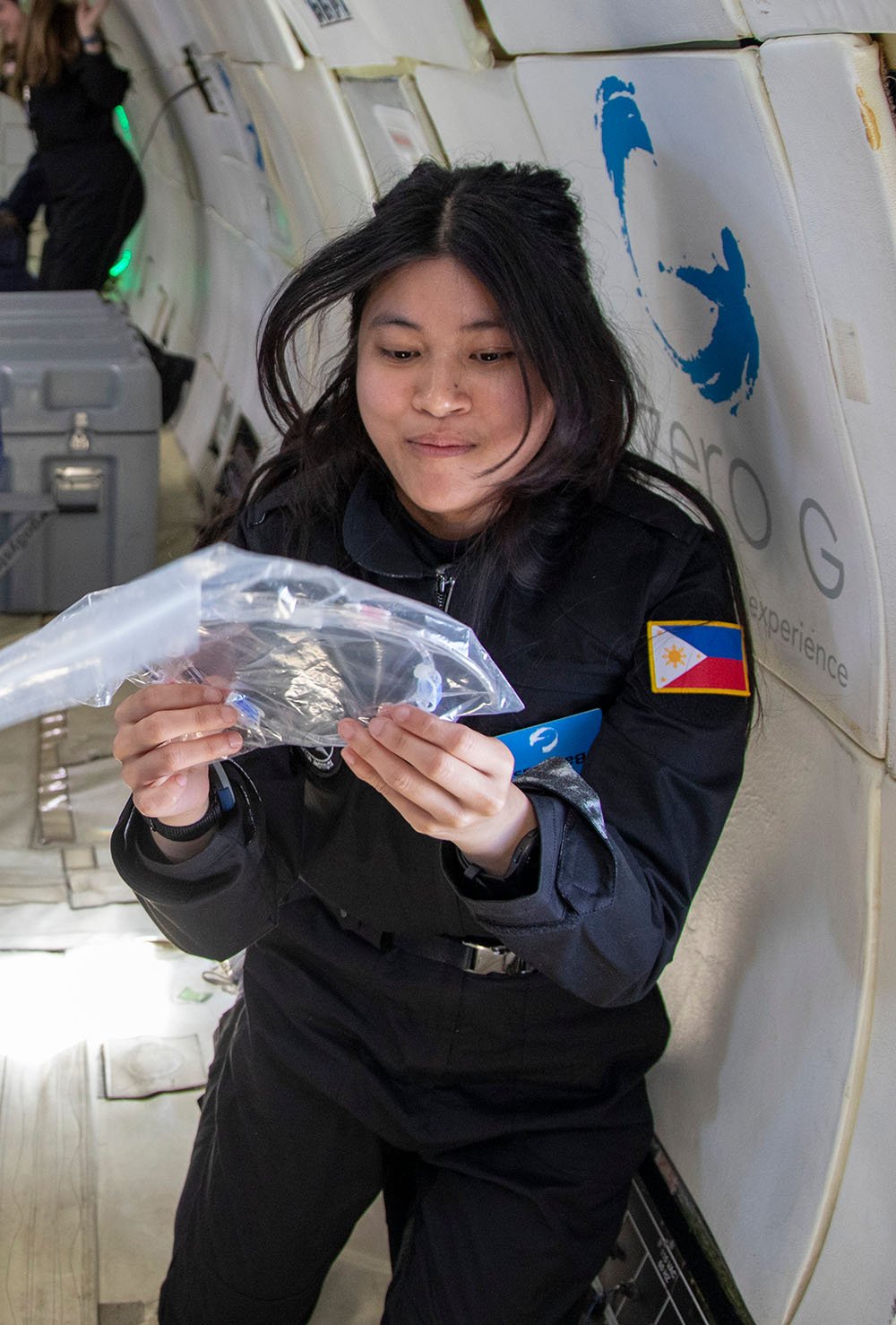Floating with purpose on Aurelia’s Zero Gravity Flights
Aurelia flew 48 people and 24 projects on two parabolic research flights
Photo credit: Blaga Ditrow / ZERO-G
This May we were delighted to lead two back-to-back zero gravity flights, each representing a cohort of Aurelia’s Horizon program. The culmination of months (and, in some cases, years) of preparation, the two flights saw 24 projects and experiments run by 48 fliers, all part of Aurelia’s unique and growing network of professionals working toward a space-ready future.
Aurelia’s Horizon Zero Gravity program combines hands-on training and education with a focus on making the practical realities of aerospace engineering and the rigors of human spaceflight accessible to fliers from nontraditional backgrounds. Across the two flights, 43 people were first-time fliers in microgravity. They joined us as representatives from nonprofit organizations, fellowships, research labs, and startups, all with vastly different goals—but all aligned in the mission to be a part of the new Space Age.
Each Horizon zero gravity flight comprised ~24 parabolas that let fliers experience brief periods of Lunar, Martian, and microgravity.
Credit: Blaga Ditrow / ZERO-G
The first cohort, Horizon 2023 (rescheduled from last year) was the inaugural class of Aurelia Academy’s Microgravity Project Design course. Guided by our experts and course materials, each flier designed, built, installed, and operated a project specifically for testing in the context of microgravity.
The Horizon 2024 cohort also completed the Microgravity Project Design course; additionally, this group brought together representatives from fellowships and nonprofits with startups—fliers working on R&D projects on behalf of their companies, all part of sister organization Aurelia Foundry’s network.
Horizon Highlights
Health and Science
Anastasia Prosina, representing AIAA SATC, drew inspiration from sensory tools like weighted blankets and pressure vests in designing her project, Space Hug, a deep pressure therapy suit for sleep in space. Based on peer-reviewed studies and ongoing consultations with medical personnel at NASA's Johnson Space Center, Anastasia’s research explores the potential for deep pressure therapy vests to manage stress in spacefarers.
Astronauts frequently report experiencing the sensation of falling when trying to sleep and often require medication to fall asleep. This investigation focuses on whether deep pressure therapy can effectively minimize astronauts' stress responses. Anastasia tested the functionality of Space Hug on the flight, with the eventual goal of aiding sleep in space.
Anastasia Prosina on board G-Force One, testing her Space Hug project. Credit: Blaga Ditrow / ZERO-G
Matej Poliacek running his RESPIRE-1 project during a period of weightlessness. Credit: Blaga Ditrow / ZERO-G
Matej Poliacek, representing the Space Generation Advisory Council, ran an experiment called RESPIRE-1, the first phase of a larger project (Repeatable Experiment for Simulation of Particles from Inhaler in REduced gravity) which aims to understand how aerosols behave in microgravity, particularly focusing on their circulation and deposition in the lung architecture. RESPIRE-I studies aerosol behavior in a trachea-like tube. RESPIRE uses a 3D mechanical model approximating lung architecture, employing a hand-operated air pump and an aerosol delivery device to mimic breathing patterns and evaluate particle behavior.
Matej hopes that a better understanding of the effectiveness of asthma medication such as inhalers in microgravity may broaden astronaut profiles and promote inclusive access to space, while potentially benefiting life on Earth as well.
Florence Pauline Basubas, representing the Space Generation Advisory Council, ran a series of low-cost space biology experiments during the flight: three passive bacterial experiments to test how the microorganisms can potentially survive, mutate, and evolve in relevant microgravity environments; and two fluid dynamic experiments of water and dye, testing different designs for future research. The goal of the project is to address the challenges of conducting space biology experiments on parabolic flights by developing and demonstrating a single, low-cost payload housing diverse experiments.
Florence Pauline Basubas observing her experiment during the flight. Credit: Blaga Ditrow / ZERO-G
Technology and R&D
ESA-backed startup Lodestar Space is developing cost-effective, fully modular robotics to enable servicing and object capture in space. Senior Engineer Kiran De Silva flew with Project Inception, a successful pre-flight testing campaign designed to demonstrate Lodestar’s proprietary autonomous object tracking & inspection capability via their vacuum-rated arm, called TARS. Designed for in-orbit servicing & manufacturing applications, TARS operated successfully through both micro and hyper-gravity. Cici Hall, a Zenith Fellow, was paired with the Lodestar team to apply her aerospace engineering skills to support the project on the flight.
Kiran De Silva at the top of a parabola. Credit: Ashly Covington / ZERO-G
Nathalie Vilchis Lagunes, a Brooke Owens Fellow, flew with her soft robotics project AVRO (Aerospace Vine Robot Operation). Vine robots are made from an inflatable plastic tube that can be pre-formed or controlled to reach a certain point in space as it grows. On Earth, vine robots' ability to grow opposite to gravity is limited: they can only reach a certain length before collapsing under their own weight. This was the first time a vine robot has been tested in microgravity, where those constraints are removed.
Vine robots are ultra-lightweight, have a reduced initial volume, and require very little energy, making them ideal mechanisms for space applications. The growing functionality occurs by supplying air to the plastic roll tube at the robot's base, inflating the plastic vine. Nathalie’s experiment was designed to analyze AVRO’s behavior, limitations, and potential to hold and move objects around in a microgravity environment. Cadence Payne, a Matthew Isakowitz Fellow, assisted Nathalie on the flight.
Nathalie Vilchis Lagunes, center, adjusting her AVRO project. Credit: Blaga Ditrow / ZERO-G
Startup Magma Space is developing a low-power magnetic reaction wheel to drastically reduce satellite vibrations and boost pointing accuracy, critical for high-resolution imaging, laser communication and national security. Founder Alessandro Stabile flew with a prototype of a single magnetically levitated wheel.
Expression and Lifestyle
Marques Redd and Mikael Owunna depicting an image from their Cosmic Ascension project during a Martian gravity parabola. Credit: Ashly Covington / ZERO-G
Marques Redd and Mikael Owunna are the co-founders of Rainbow Serpent, a Black LGBTQ+ arts nonprofit. They flew with their project Cosmic Ascension: The Flying Africans, a reimagining of Owunna’s photographic image "The Flying African" in the context of microgravity.
The Flying African draws on a tradition of stories of enslaved Africans who escaped bondage by taking flight and returning to their African homelands. With a central figure whose body is illuminated as the starry universe itself, "The Flying African" creates a powerful homage to its source myth through visually rendering ideas about the blackness of space, ocean depths, the womb, and the primordial origin from which all things emerge, and to which they return.
Marques and Mikael flew in shimmering body suits to capture images and video of themselves floating in their signature style, using the effects of weightlessness to bring new dimensions to the mythology behind it. Their project is intended to express narratives of liberation, journey, and connection across dimensions, and explore African spirituality in the context of the cosmos, and amplify the narratives of Black LGBTQ artists to foster a sense of belonging and representation in the final frontier.
Jagriti Luitel flew representing Zero-G Couture: Nepalese Red Rhododendrons for Space Fashion. This project featured a custom design from Deborah Won’s fashion startup Pisces Rising, a label focused on clothing designed for a zero-gravity environment. Nepalese-born Jagtiri wore a garment woven with red rhododendrons, the national flower of Nepal, using materials that cater to the unique demands and challenges of microgravity. This endeavor explores the intersection of aesthetics and functionality in space wear to envision a vibrant life for the future of space civilization.
Jagriti Luitel wearing her Zero-G Couture project. Credit: Ashly Covington / ZERO-G
A Plethora of Projects
Across the two flights there were a total of 24 projects flown, including:
Aural-ia: Sound Personalization for the Hard-of-Hearing in Noise and Zero Gravity: AstroAccess advisor Larry Guterman flew an experiment using technology from SonicCloud, the startup he co-founded after experiencing hearing loss.
HUNCH One-Handed Trash Bag Container: Representing NASA HUNCH, Mirabella Herrera flew with a prototype to improve the trash disposal system currently in use on the ISS.
Visualizing STEM: Abby Lee, representing the Zenith Pathways Fellowship, flew an experiment she designed and built that targets educating elementary school and high-school-level students on the effects of gravity.
Keeping Track of Floating Objects and Inventory: Kaylon Paterson was selected by the NSBE Aerospace Special Interest Group to fly his experiment that uses machine learning to track small, hard-to-contain items in varying gravitational profiles.
It’s Vital: Abigail Rajagopal, representing the Zed Factor Fellowship, used a tethered computer to output data from devices tracking her heartbeat and orientation over time, to compare these values across Martian, Lunar, and zero gravity sections of the flight. She plans to use the data in her research at the Aerospace Human Systems Laboratory at Texas A&M University.
GIRL IN SPACE CLUB Flight Suit: Founder Sabrina Thompson tested out her company’s patent-pending women’s flight suit.
Wearable Gecko Mobility Aids: The Patti Grace Smith Fellowship selected Brandon Wells for Horizon to test out his project, which uses Van Der-Waals forces induced by shear forces to adhere to smooth surfaces and are a possible alternative to handrails and foot restraints on spacecraft.
Automatic Light Signaling System: Brenda Williamson tested out a new system that builds on a manual LED light system developed for AstroAccess parabolic research flights. The system uses visuals, rather than sound, to signal changes in gravity status during the flight and inform deaf or hard-of-hearing crew.
TESSERAE: A team from Aurelia also flew with the latest iteration of our TESSERAE Gen-4 tiles, following up on initial zero gravity experiments earlier this year.
Thanks to our Sponsors
We are deeply grateful to our Horizon 2023–2024 sponsors — Aerospace Corporation, Autodesk, Teague, and Voyager Space — for supporting the launch of 24 projects, and furthering access to microgravity research for 48 fliers.











